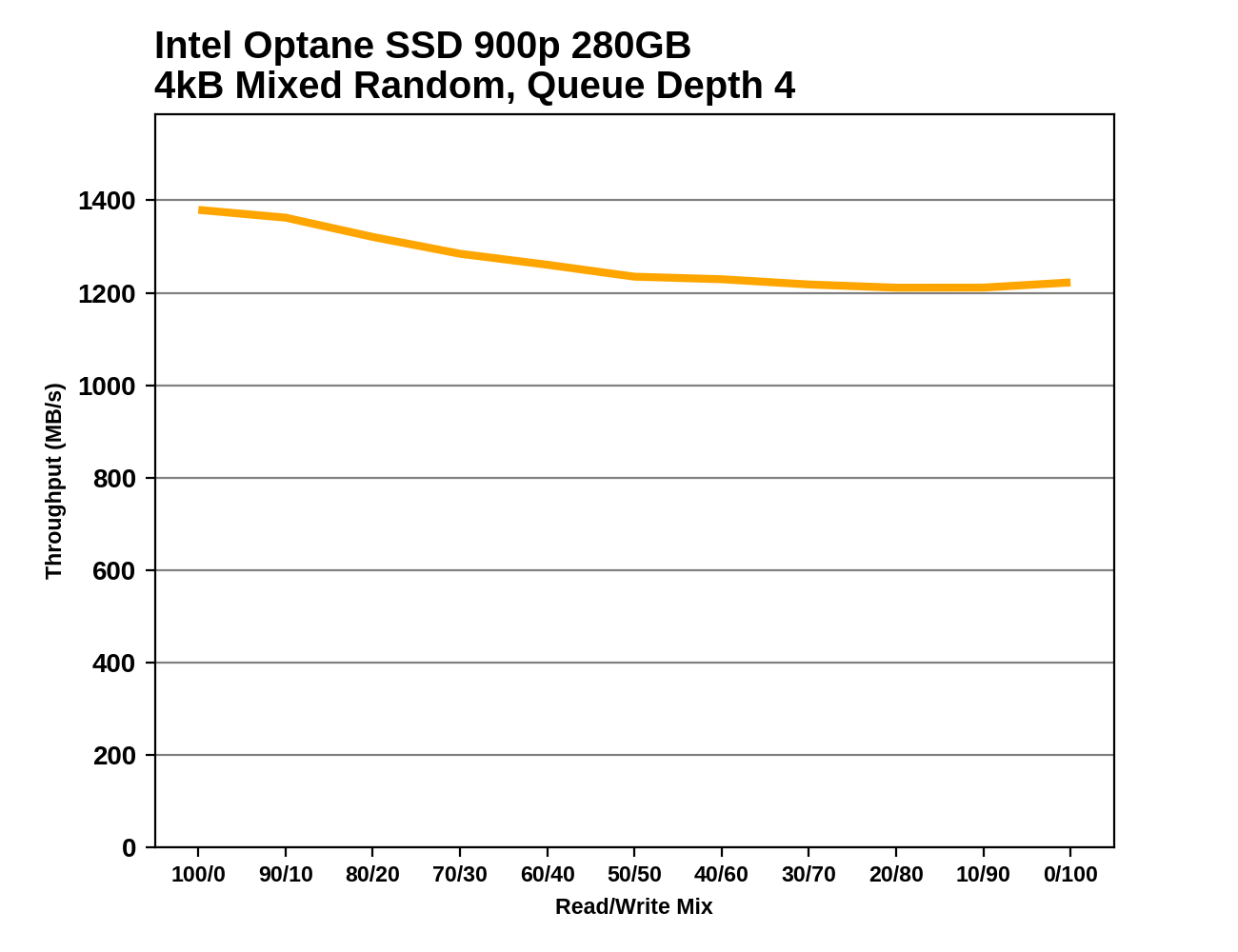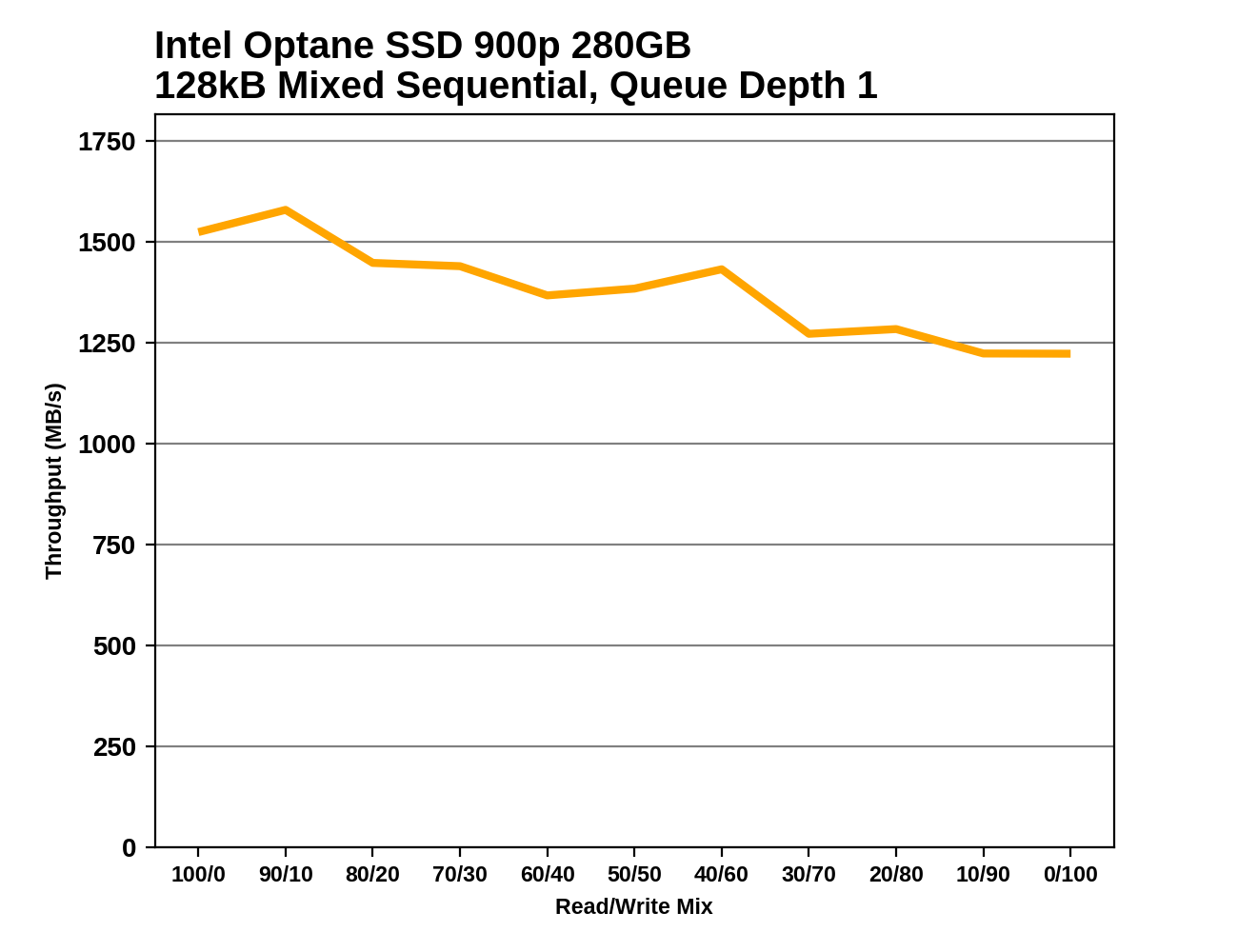The Intel Optane SSD 900P 280GB Review
by Billy Tallis on October 27, 2017 9:30 AM ESTMixed Random Performance
Our test of mixed random reads and writes covers mixes varying from pure reads to pure writes at 10% increments. Each mix is tested for up to 1 minute or 32GB of data transferred. The test is conducted with a queue depth of 4, and is limited to a 64GB span of the drive. In between each mix, the drive is given idle time of up to one minute so that the overall duty cycle is 50%.

The mixed random I/O performance of the Intel Optane SSD 900P is completely unmatched. The small Optane Memory M.2 is the second fastest drive we've tested, and the fastest flash-based SSD is only a third as fast as the Optane SSD overall.
 |
|||||||||
At the very end of the test, when the workload shifts to pure random writes, Samsung's fastest SSDs are able to batch the writes and dramatically improve throughput, almost enough to catch up to the slowest speed the Optane SSD hits during this test.
Mixed Sequential Performance
Our test of mixed sequential reads and writes differs from the mixed random I/O test by performing 128kB sequential accesses rather than 4kB accesses at random locations, and the sequential test is conducted at queue depth 1. The range of mixes tested is the same, and the timing and limits on data transfers are also the same as above.

The Intel Optane SSD 900P doesn't quite dominate the mixed sequential I/O test to the extent that it trounced the competition in the mixed random I/O test, but it still breaks the record with a 40% higher average throughput than the fastest flash-based SSD.
 |
|||||||||
The Optane SSD 900P's performance wavers a bit as the workload changes, but the general trend is a gradual reduction in performance as the proportion of writes increases. The flash-based SSDs tend to show an sharper decline in performance during the first half of the test, and the good ones recover most of that performance over the course of the second half. But the low performance in the middle of the test brings the averages way down and leaves the Optane SSD alone at the top.










205 Comments
View All Comments
phaethon1 - Tuesday, November 14, 2017 - link
Nice post,I read in multiple channels about this SSD being able to be used as extra RAM. Then I contacted the technical support of Intel, and they do not have any clue about a software to enable this feature. Any ideas?
extide - Friday, October 27, 2017 - link
SLC might be faster in sequential, but if you want sequential stripe a bunch of platters ..Also, I didn't say bit-level, I said block level. They present 512b blocks so you would assume the drive manages 'pages' in the size of 512b even though the underlying memory can be more fine-grained. SLC can't do that, plus there is still the whole garbage collection thing. If your hypothetical drive was actually a good idea, someone would make it. That's proof enough that it's not.
ddriver - Friday, October 27, 2017 - link
They didn't make one not because it is not good enough, but because it would be too good.That would set a bad precedent. Before you know it, people will start demanding quality rather than being content with what the industry dictates to them.
Of course, if hypetane manages to make enough a hole in the pockets of big players, we will definitely be seeing some of that long-possible, deliberately untapped potential coming to life.
"That's proof enough that it's not."
You know, they make trucks that drive 24/7, under huge loads, and can go much long without maintenance than a regular personal vehicle. That's proof enough that the industry doesn't make things as good as it can, obviously, if it can make a heavily used and loaded truck more durable, that would be not only possible, but actually much easier to achieve for a regular car that's driven less, under less load. Yet they don't make it, even if that ends up costing human lives. And the reason for that is moar profit. Which is why they chose to only overbuild trucks, because that too maximizes profits. But not cars. Cars are far more profitable if need more servicing, and that doesn't result in profit losses as it would if it was commercial trucks, and if underbuilt cars end up costing human lives, that's a small price to pay for more profit. Engineering wise, is entirely possible and easily doable to make a car about 10 times more durable, and requiring 10 times less maintenance, and 10 times safer too, but they'd rather get the extra profit. And keep good engineering exclusive to military and commercial production.
The reason they haven't made it is they didn't have a reason to make it. And the reason intel did hypetane is only because it has been a very long time since they did anything new. They had that in the works, and decided to release it in order to demonstrate some innovation, unfortunately, not without shamelessly lying about how well it will perform in advance.
Xpl1c1t - Friday, October 27, 2017 - link
ddriver, i like your analysis. maybe the review system just wasnt equipped with rgb lighting, that would explain at least one order of magnitude of error in their results vs Intel's promisesjospoortvliet - Friday, November 3, 2017 - link
> Engineering wise, is entirely possible and easily doable to make a car about 10 times more durable, and requiring 10 times less maintenance, and 10 times safer too, but they'd rather get the extra profit. And keep good engineering exclusive to military and commercial production.Well, yes, they care about their profits: nobody would buy such a super-durable car because it would cost 5-10x the price and people will go for the cheaper car, even though it has higher maintenance cost. This is true for nearly ANY product on the market: sure, you could built houses more durable, or bikes, or... you name it. But people prefer 'good enough' over 'perfect', always have. And they're not entirely stupid - many products' practical life time is fine, people quite like buying a new car every 3-5 years. Or new cups. Or new forks and knives.
Yes, some folks pay the 10x price to get the perfect, durable stuff. But most buy pressed wood closets at Ikea and are happy with it.
Gastec - Saturday, March 10, 2018 - link
I'm not sure if you are both ironic or are just too rich to think straight.AlishaScott - Sunday, October 29, 2017 - link
I just got paid $6784 working off my laptop this month. And if you think that’s cool, my divorced friend has twin toddlers and made over $9k her first month. It feels so good making so much money when other people have to work for so much less. This is what I do... http://cutt.us/O5gexNails6365 - Monday, November 6, 2017 - link
Thank you for your in-depth analysis.Given the opportunity to make a high-end rig. What would you choose ?
Jared13000 - Tuesday, May 22, 2018 - link
You’re not giving Optane enough credit, you don't necessarily compare a NAND based drive to an Optane based drive. Compare NAND to Optane, as NAND has had years of development pored into hiding its short comings that Optane has not yet had.I just built a small all flash hyper converged cluster and after setup I was getting about 500,000 random read IOPS on a quad node cluster with triple mirrored storage. Write speeds were about 1,000 IOPS, basically hard drive speeds across the 16 SSDs in the cluster.
Was it bad drivers, miss configuration, ethernet flow control issues?
None of the above. It was the drive cache. Storage spaces disabled it due to the drives not having power loss protection. Enabled the cache on all the drives to avoid direct NAND writes and now the cluster can push nearly 280,000 write IOPS. This mean with cache the drives are over 200 times faster than just writing directly to NAND.
What does this have to do with Optane? As far as I have been able to find, Optane drives don't have or need a cache. Their performance is direct to storage, without cache!
Taken in the context of NAND vs Optane, 1,000x may be embellished, but probably not by much. At this point PCIe overhead and lack of software optimization may be the only reason it’s not 1,000x faster when comparing modern NAND memory.
It's not that much faster comparing a whole NAND drive with well implemented cache to an Optane drive, but some situations can't rely on cache. Also, a simpler drive should be more reliable, in theory.
As it is Optane is unrivaled until someone manages to bring a drive to market with SLC NAND and nonvolatile cache like MRAM for about twice the cost of a 970 PRO.
Just a thought, a 970 PRO 512 GB has an MSRP of $329 and the Intel 900p 280 GB has it’s MSRP at $329 as well. That is 256 GB of SLC flash vs 280 GB of Optane. Comparing an MLC drive to an SLC drive at half the capacity is a bit like comparing apples and oranges, but it’s a start for an estimate. Trade the DRAM for MRAM and bump the capacity a bit and it’s hard to imagine that a SLC NAND based drive with MRAM wouldn’t cost more than Optane.
If you expected 1,000 times SSDs that are getting multiple gigabytes per second reads and writes, then you were looking for a drive faster than CPU cache. Intel really needs to watch their wording, but that does not make this a bad product.
CheapSushi - Friday, October 27, 2017 - link
Well, then wait for Samsung's Z-NAND, which is MLC/TLC NAND treated like SLC.